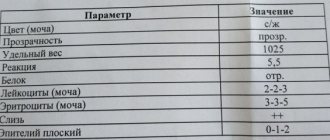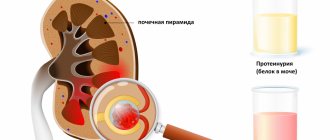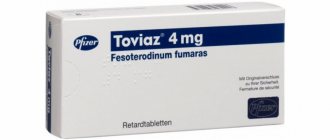Analysis of the spectrum of organic acids in urine using gas chromatography with mass spectrometry (GC/MS)
Interpretation of research results contains information for the attending physician and is not a diagnosis. The information in this section should not be used for self-diagnosis or self-treatment. The doctor makes an accurate diagnosis using both the results of this examination and the necessary information from other sources: medical history, results of other examinations, etc.
Reference values for determined parameters
| Acid name | Unit change | Ref. meaning * | Increased due to pathology/secondary causes |
| 2-hydroxybutyrate | mm/M CRE | > 3 | |
| 2-hydroxyvaleric | mm/M CRE | > 2 | |
| 2-hydroxyglutaric | mm/M CRE | > 16 | |
| 2-hydroxyphenylacetate | mm/M CRE | > 2 | |
| 2-Hydroxy-3-methylvaleric | mm/M CRE | > 2 | |
| 2-hydroxyisobutyrate | mm/M CRE | > 2 | |
| 2-hydroxyisovaleric | mm/M CRE | > 2 | |
| 2-hydroxyisocaproic | mm/M CRE | > 2 | |
| 2-methyl-3-hydroxybutyrate | mm/M CRE | > 11 | |
| 2-Methyl acetoacetate | mm/M CRE | not normally determined | > 0 |
| 2-methylbutyrylglycine | mm/M CRE | > 2 | |
| 2-oxo-3-methylvaleric | mm/M CRE | > 2 | |
| 2-oxoadipic | mm/M CRE | > 2 | |
| 2-oxobutyrate | mm/M CRE | > 2 | |
| 2-oxoglutaric | mm/M CRE | > 152 | |
| 2-oxoisovaleric | mm/M CRE | > 2 | |
| 2-oxoisocaproic | mm/M CRE | > 2 | |
| 3,4-dihydroxybutyrate | mm/M CRE | not normally determined | > 0 |
| 3-hydroxy-3-methylglutaric | mm/M CRE | > 36 | |
| 3-hydroxybutyrate | mm/M CRE | > 3 | |
| 3-hydroxyglutaric | mm/M CRE | > 2 | |
| 3-hydroxydecanedioic | mm/M CRE | > 2 | |
| 3-hydroxyisobutyrate | mm/M CRE | > 2 | |
| 3-hydroxyisovaleric | mm/M CRE | > 46 | |
| 3-hydroxyisocaproic | mm/M CRE | > 2 | |
| 3-hydroxypropionic | mm/M CRE | 3-10 | > 10 |
| 3-hydroxysebacic | mm/M CRE | > 2 | |
| 3-methylglutaconic | mm/M CRE | > 9 | |
| 3-methyladipic | mm/M CRE | > 2 | |
| 3-methylglutaric | mm/M CRE | > 7 | |
| 3-methylcrotonylglycine | mm/M CRE | > 2 | |
| 4-hydroxybutyrate | mm/M CRE | > 2 | |
| 4-hydroxyisovaleric | mm/M CRE | > 2 | |
| 4-Hydroxyphenylacetate | mm/M CRE | 6 — 28 | > 28 |
| 4-hydroxyphenyllactate | mm/M CRE | 6 — 28 | > 28 |
| 4-hydroxyphenylpyruvate | mm/M CRE | > 2 | |
| 5-hydroxyhexane | mm/M CRE | > 7 | |
| 7-hydroxyoctane | mm/M CRE | > 2 | |
| N-acetylaspartate | mm/M CRE | > 2 | |
| Adipic | mm/M CRE | > 12 | |
| Acetoacetate | mm/M CRE | > 2 | |
| Butyrylglycine | mm/M CRE | > 2 | |
| Vanillyl lactate | mm/M CRE | > 0,6 | |
| Vanillylmandeline | mm/M CRE | > 15 | |
| Hexanoylglycine | mm/M CRE | > 2 | |
| Glycolic | mm/M CRE | 11 — 103 | > 103 |
| Glycerol | mm/M CRE | > 9 | |
| Glutaric | mm/M CRE | > 2 | |
| Homovanillic | mm/M CRE | 2 — 15 | > 15 |
| Homogentisic | mm/M CRE | > 10 | |
| Isobutyrylglycine | mm/M CRE | > 2 | |
| Isovalerylglycine | mm/M CRE | > 2 | |
| Lactate | mm/M CRE | > 25 | |
| Malikovaya | mm/M CRE | > 2 | |
| Malonovaya | mm/M CRE | > 2 | |
| Mevalon Lactone | mm/M CRE | > 2 | |
| Methylmalonic | mm/M CRE | > 2 | |
| Methyl succinate | mm/M CRE | > 3 | |
| Methyl citrate | mm/M CRE | > 12 | |
| Orotovaya | mm/M CRE | > 11 | |
| Pyruvate | mm/M CRE | >12 | |
| Propionylglycine | mm/M CRE | > 2 | |
| Sebacine | mm/M CRE | > 2 | |
| Suberylglycine | mm/M CRE | > 2 | |
| Suberic | mm/M CRE | > 2 | |
| Succinate | mm/M CRE | 0,5 — 16 | > 16 |
| Succinylacetone | mm/M CRE | > 2 | |
| Tiglilglycine | mm/M CRE | > 2 | |
| Phenyl lactate | mm/M CRE | > 2 | |
| Phenylpyruvate | mm/M CRE | > 2 | |
| Fumarovaya | mm/M CRE | > 2 | |
| Ethymalon | mm/M CRE | > 7 |
* Reference values have no age differences.
Characteristic profiles of organic acids in hereditary metabolic diseases determined by GC/MS
| № | Diseases caused by impaired amino acid metabolism | Metabolites: ↑ |
| 1 | Leucinosis (branched chain ketonuria, maple syrup urine disease, maple syrup disease) | 2-oxoisocaproic, 2-oxoisovaleric, 2-oxo-3-methylvaleric, 2-hydroxyisocaproic, 2-hydroxyisovaleric, 2-hydroxy-3-methylvaleric acid: ↑ |
| 2 | Tyrosinemia type 1 | 4-hydroxyphenyl lactate, succiniacetone, 4-hydroxyphenylpyruvate: ↑ |
| 3 | Tyrosinemia type 2 | 4-hydroxyphenyllactate, 4-hydroxyphenylpyruvate: ↑ |
| 4 | Phenylketonuria | Phenyl lactate, phenylpyruvate, 2-hydroxyphenylacetate, 4-hydroxyphenyl lactate, 4-hydroxyphenylpyruvate: ↑ |
| Organic aciduria | Metabolites: ↑ | |
| 5 | Isovaleric acidemia | 3-hydroxyisovaleric acid, isovaleriglycine: ↑ |
| 6 | 3-methylcrotonyl-CoA carboxylase deficiency | 3-hydroxyisovaleric acid, 3-methylcrotonylglycine: ↑ |
| 7 | Multiple carboxylase deficiency | 3-hydroxyisovaleric acid, lactate, methyl citrate, 3-hydroxypropionic acid, 3-methylcrotonylglycine: ↑ |
| 8 | 3-hydroxy-3-methylglutaric aciduria | 3-hydroxy-3-methylglutaric acid, 3-methylglutaconic acid, 3-methylglutaric acid, 3-hydroxyisovaleric acid, 3-methylcrotonylglycine: ↑ |
| 9 | 3-methylglutaconic aciduria (9 types) | 3-methylglutaconic acid, 3-methylglutaric acid |
| 10 | 3-ketothiolase deficiency | 2-methyl-3-hydroxybutyrate, 2-methylacetoacetate, 3-hydroxybutyrate, tiglylglycine, acetoacetate: ↑ |
| 11 | 2-methylbutyryl-CoA dehydrogenase deficiency | 2-methylbutyrylglycine: ↑ |
| 12 | 2-methyl-3-hydroxybutyryl-CoA dehydrogenase deficiency | 2-methyl-3-hydroxybutyrate, tiglylglycine: ↑ |
| 13 | Propionic acidemia | 3-hydroxypropionic acid, methyl citrate, propionylglycine, tiglylglycine: ↑ |
| 14 | Methylmalonic aciduria (various types) | Methylmalonic acid, 3-hydroxypropionic acid, methyl citrate: ↑ |
| 15 | Glutaric acidemia type 1 | Glutaric acid, 3-hydroxyglutaric acid: ↑ |
| 16 | Biotinidase deficiency | 3-hydroxyisovaleric acid, 3-hydroxypropionic acid, tiglylglycine, 3-methylcrotonylglycine, methyl citrate, lactate: ↑ |
| Diseases caused by impaired B-oxidation | Metabolites: ↑ | |
| 17 | Glutaric acidemia type 2 (multiple acyl-CoA dehydrogenase deficiency) | Glutaric acid, ethylmalonic acid, adipic acid, suberic acid, 2-hydroxyglutaric acid, isovalerylglycine, isobutyrylglycine, 2-methylbutyrylglycine: ↑ |
| 18 | Fazio-Londe/Brown-Violette-van Leyer syndrome | Glutaric acid, ethylmalonic acid, adipic acid, suberic acid, 2-hydroxyglutaric acid, isovalerylglycine, isobutyrylglycine, 2-methylbutyrylglycine: ↑ |
| 19 | Short-chain fatty acid acyl-CoA dehydrogenase deficiency | Ethylmalonic acid: ↑ |
| 20 | Medium chain acyl-CoA fatty acid dehydrogenase deficiency | 5-hydroxyhexanoic, 7-hydroxyoctane, adipic, suberic, sebacic acids, hexanoylglycine, suberylglycine: ↑ |
| 21 | Very long chain fatty acid acyl-CoA dehydrogenase deficiency | Adipic, suberic, sebacic acids: ↑ |
| 22 | Long-chain 3-hydroxyacyl-CoA fatty acid dehydrogenase deficiency | Adipic, suberic, sebacic acids, 3-hydroxybutyrate, 3-hydroxyisobutyrate, acetoacetate: ↑ |
| 23 | Trifunctional mitochondrial protein deficiency | Suberic, sebacic, 3-hydroxysebacic: ↑ |
| 24 | Short-chain 3-hydroxy-acyl-CoA dehydrogenase deficiency | 3,4-dihydroxybutyrate, 3-hydroxyglutaric acid: ↑ |
| 25 | Carnitine acylcarnitine translocase deficiency | Adipic, suberic, sebacic acids: ↑ |
| 26 | Ethylmalonic encephalopathy | Ethylmalonic acid, isovalerylglycine, methylsuccinate, 2-methylbutyrylglycine, isobutyrylglycine: ↑ |
| Urea cycle disorder | Metabolites: ↑ | |
| 27 | NNN syndrome, arginemia, ornithine transcarbamylase deficiency, arginine succinic aciduria, type 1 citrullinemia | Orotic acid: ↑ |
| 28 | Carbamoylphosphate synthase deficiency | 3-methylglutaconic acid: ↑ |
| Carbohydrate metabolism disorder | Metabolites: ↑ | |
| 29 | Fructose 1,6-biphosphatase deficiency | Lactate, glycerol: ↑ |
| 30 | Glycogenosis type 1 | Lactate, 3-methylglutaconic acid, 3-methylglutaric acid: ↑ |
| 31 | Galactosemia | 4-hydroxyphenyllactate, 4-hydroxyphenylpyruvate: ↑ |
| 32 | Hereditary fructose intolerance | 4-hydroxyphenyllactate, 4-hydroxyphenylpyruvate: ↑ |
| 33 | Pyruvate dehydrogenase deficiency | Lactate, 2-oxoglutaric acid, succinate, malic acid, 2-oxoisocaproic acid, 2-oxoisocaproic acid, 2-oxo-3-methylvaleric acid, 2-hydroxyisocaproic acid, 2-hydroxyisovaleric acid, 2-hydroxy-3-methylvaleric acid: ↑ |
| 34 | Pyruvate carboxylase deficiency | Lactate, pyruvate, succinate, malic acid, fumaric acid: ↑ |
| 35 | Primary and secondary mitochondrial pathologies | Lactate, pyruvate, succinate, malic acid, fumaric acid, 2-hydroxyisobutyrate, 3-hydroxybutyrate, 2-oxoglutaric acid: ↑ |
| Other | Metabolites: ↑ | |
| 36 | Lactate acidosis | Lactate, pyruvate, 2-hydroxybutyrate, 2-hydroxyisobutyrate, 3-hydroxybutyrate, 4-hydroxyphenyllactate: ↑ |
| 37 | Hyperoxaluria type 1 | Glycolic acid: ↑ |
| 38 | Glycerol kinase deficiency | Glycerol: ↑ |
| 39 | 3-hydroisobutyrate aciduria/ketoacidosis | 3-hydroxyisobutyrate, acetoacetate: ↑ |
| 40 | Fumaric aciduria | Fumaric acid, lactate, 2-oxoglutaric acid, succinate: ↑ |
| 41 | Malonic aciduria | Malonic, methylmalonic acid: ↑ |
| 42 | Mevalonic aciduria | Mevalon lactone (may be normal outside of crisis): ↑ |
| 43 | Alkaptonuria | Homogentisic acid: ↑ |
| 44 | Canavan disease | N-acetylaspartate: ↑ |
| 45 | Impaired peroxisome biogenesis | Adipic, suberic, sebacic, 3-hydroxysebacic acids, 4-hydroxyphenyllactate: ↑ |
| 46 | 2-hydroxyglutaric aciduria | 2-hydroxyglutaric acid: ↑ |
| 47 | Aromatic L-amino acid deficiency | Vanillyl lactate: ↑ |
| 48 | Neuroblastoma | Vanillyl lactate, homovanillic, vanilla almond: ↑ |
| 49 | Neurotransmitter metabolism disorder | Vanillyl lactate, homovanillic, vanilla almond: ↑ |
| 50 | Semialdehyde dehydrogenase deficiency (4-hydroxybutyrate acidurium) | 4-hydroxybutyrate, 3,4-dihydroxybutyrate: ↑ |
Analysis for organic acids (23 indicators) (GC-MS)
Organic acid analysis
— determination of the concentration of various organic acids in urine, the appearance of which indicates a violation of metabolic pathways in the body and is a marker of diseases from the group of organic acidurias.
List of tests included in the study:
- Glycolic acid.
- 3-hydroxybutyric acid.
- Methylmalonic acid.
- 2-ethyl-3-hydroxybutyric acid.
- 2-hydroxyisocaproic acid.
- Ethylmalonic acid.
- Succinic acid.
- Glyceric (D, L-isomer) acid.
- Glutaric acid.
- 3-methylglutaric acid.
- Glyoxylic acid.
- Adipic acid.
- Pyruvic acid.
- Mevalonic acid.
- 3-hydroxy-3-methylglutaric acid.
- 4-Hydroxyphenylacetic acid.
- N-acetylaspartic acid.
- Suberic acid.
- Homogentisic acid.
- Hippuric acid.
- Sebacic acid.
- Phenylpyruvic acid.
- 4-Hydroxyphenylpyruvic acid.
Organic acids
are intermediate products of the breakdown of many substances, the metabolism of which occurs in the human body. They play a major role in the conversion of energy from nutrients and are intermediate metabolic products. The concentration of organic acids reflects the level of carbohydrate metabolism and characterizes the functioning of mitochondria and the process of cellular respiration in them. The organic acids measured in the study are the main components as well as intermediate products of metabolic energy conversion during the Krebs cycle.
Indications for use in adults:
Analysis for organic acids allows us to identify abnormalities in metabolism due to intoxication, intestinal dysbiosis, pathological changes in blood glucose concentrations, oxidative load, nutritional deficiencies, poor nutrition and other reasons.
Symptoms suggesting an imbalance of organic acids in the body:
- chronic ailments, headaches;
- fibromyalgia, decreased tone of skeletal muscles, pain in muscles and joints;
- low endurance of the body.
Indications for use in children:
Analysis of urine organic acids is an important stage in the examination of a child who is suspected of having inborn errors of metabolism.
The study is carried out if:
- specific, strange smell of urine;
- metabolic acidosis, transient or permanent, with an increased or normal anion gap;
- persistent vomiting, especially if metabolic acidosis is observed;
- acute illness in infancy, especially if hyperammonemia and metabolic acidosis are observed;
- progressive extrapyramidal symptoms;
- Reye's syndrome, especially when it occurs in infancy, in the presence of repeated attacks and a family history;
- any hereditary disease with an unknown cause.
Preparation
On the eve of the test, it is not recommended to eat vegetables and fruits that can change the color of urine (beets, carrots, cranberries, etc.), or take diuretics.
Collect a strictly morning portion of urine, excreted immediately after sleep. Before collecting urine, it is necessary to perform a thorough hygienic toilet of the external genitalia. When urinating for the first time in the morning, release a small amount of urine (the first 1-2 seconds) into the toilet, then collect the entire portion of urine in a clean container without interrupting urination. Pour approximately 50 ml of urine into a sterile plastic container with a screw cap. When collecting urine, it is advisable not to touch the container to your body. It is necessary to deliver the container with urine to the medical office as soon as possible from the moment the biomaterial is taken.
Women are not recommended to take a urine test during menstruation.
Interpretation of results (unit mmol/mol creatinine)
| Test name | Reference values | |||
| up to 1 month | up to 5 years | 5-18 years | from 18 years old | |
| 2-hydroxyisocaproic acid | 0–5 | 0 | 0 | 0 |
| 2-ethyl-3-hydroxybutyric acid | 0–12 | 0–19,9 | 0–19,8 | 0 |
| 3-hydroxy-3-methylglutaric acid | 15–43 | 6,2–49,7 | 0–28 | 0–10 |
| 3-hydroxybutyric acid | 0–19 | 10–36 | 0–20 | 0 |
| 3-methylglutaric acid | 0 | 0 | 0 | 0 |
| 4-Hydroxyphenylpyrogratic acid | 0–74 | 0–0,4 | 0–0,3 | 0 |
| 4-Hydroxyphenylacetic acid | 3–240 | 12,3–174 | 7,4–30,1 | 3,5–22 |
| N-acetylaspartic acid | 5–34 | 7–40,8 | 6–21,6 | 0 |
| Adipic acid | 0–32 | 0–34,3 | 0–5,3 | 0,8–35 |
| Hippuric acid | 2–122 | 119–1390 | 58–746 | 170–391 |
| Glycolic acid | 1–40 | 0,2–198 | 43–172 | 18–55 |
| Glyoxylic acid | 0–20 | 0,29–15,9 | 0,2–5,7 | 0 |
| Glyceric (D,L-isomer) acid | 0,2–40,5 | 4,2–32,2 | 2,6–28,2 | 0,2–6 |
| Glutaric acid | 0–3 | 0–5,3 | 0–3,8 | 0,6–2,6 |
| Homogentisic acid | 0 | 0 | 0 | 0 |
| Mevalonic acid | 0,3–0,4 | 0,1–0,3 | 0,1–0,2 | 0,1–0,2 |
| Methylmalonic acid | 0–5 | 0 | 0 | 0 |
| Pyruvic acid | 4,5–130 | 5,1–22,6 | 3,5–17,3 | 2,6–7,9 |
| Sebacic acid | 0–57 | 0–1,4 | 0–1,5 | 0 |
| Suberic acid | 0–20 | 0–10,1 | 0–8,8 | 0–2,9 |
| Succinic acid | 13–125 | 7,6–79,2 | 4,9–81,3 | 0,5–16 |
| Phenylpyruvic acid | 0–15,5 | 0 | 0 | 0 |
| Ethylmalonic acid | 0–6,5 | 1,7–14,6 | 0–8,4 | 0,4–4,2 |









